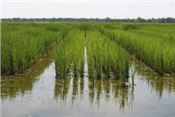|
With Practically No Early Planting, COVID-19 Impacts On Rice, If Any, Remain To Be Seen

Due to steady, intermittent rainfall throughout the winter and spring, essentially no rice was early planted for 2020.
Division of Agriculture photo
LITTLE ROCK, ARK.
Finally, some rice is in the ground. Barely. Jarrod Hardke, extension rice agronomist for the University of Arkansas System Division of Agriculture, said Thursday that a handful of growers began water-seeding rice, a technique that typically accounts for about 5 percent of all rice acreage in the state.
“That’s the very first rice planted in Arkansas to my knowledge,” Hardke said. “But beyond that, we’re still staring at a very difficult time to get any other rice in the ground.”
The window for early-planted rice has nearly passed, with hardly a break in the wet weather that has plagued the state for most of the past 18 months. Since Jan. 1, much of the state has received about 150 percent of its typical rainfall for the three-month window, according to data from the National Oceanic and Atmospheric Administration.
The near future forecast doesn’t look much different, with next week’s temperatures dropping back into the 60s, and more rainfall expected.
Will 2020 be a big year?
Nevertheless, 2020 still holds the potential to be a big year for Arkansas rice acreage, Hardke said, likely exceeding 1.5 million acres.
“It continues to point up,” he said.
The U.S. Department of Agriculture has conducted surveys of growers over the past two weeks, he said – the same period in which the COVID-19 pandemic has seized much of the world’s attention, leading in part to panic-buying of rice and other staples in the United States. Simultaneously, soybean and corn contract prices have dropped, while rice prices have remained relatively stable.
Market prices weigh heavily on growers’ acreage allocation decisions, and 2020 is likely to be no different.
“In theory, some of that shift in intention will show up in the prospective planting report,” Hardke said. “Given everything else that’s happened, 1.5 million acres, assuming we have the opportunity to plant it, is actually at the low end of my expectations.”
Hardke said that, as of yet, the coronavirus pandemic has had no identifiable effect of the mechanics of farming itself – although the continued delays in planting leave the state with an open question.
“We’re just unable to really do much of anything yet,” he said. “Even preparing for the season, you’re not much going into your local retailers – everything can be done over the phone.
“Everyone seems to have most of their inputs on hand,” he said. “It doesn’t seem, at this stage, like we’re going to run into major issues. But it is something everyone’s concerned about, should things continue to drag on. The first week when the weather opens up enough for us to do anything, it’s going to be a pretty good barometer of how the pandemic might affect farming. We just don’t have that information yet.” ∆
|
|